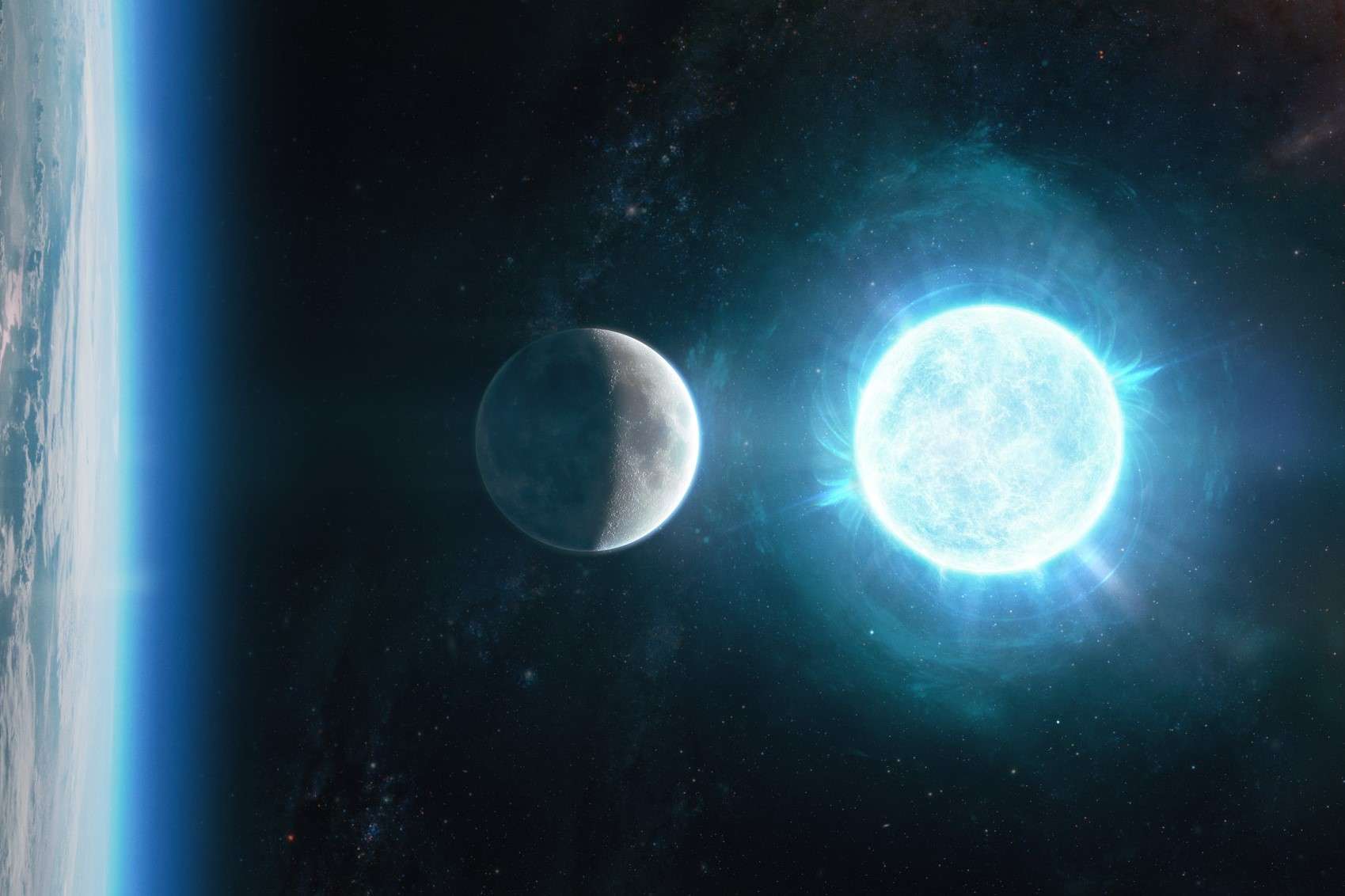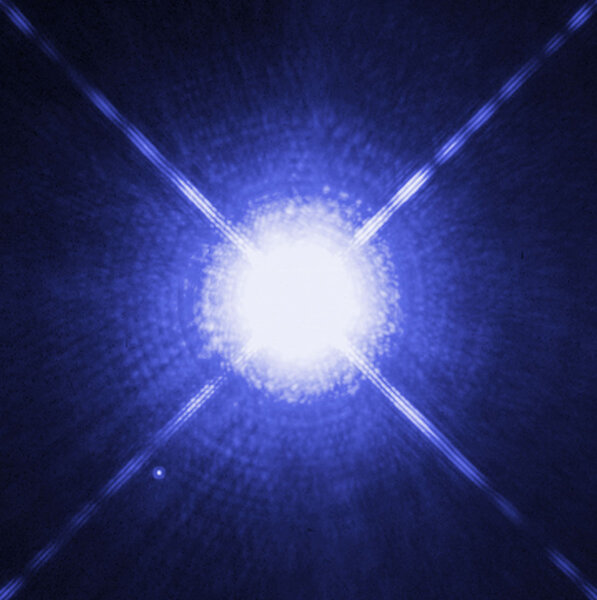Create a free profile to get unlimited access to exclusive videos, sweepstakes, and more!
Tiny but mighty: Astronomers find the smallest but most massive white dwarf ever seen

Astronomers have found a tiny but mighty dead(ish)star, a white dwarf that is both the smallest and most massive ever seen. It also spins rapidly, packs a walloping magnetic field, and might eventually collapse into an even smaller and denser neutron star.
Seriously, this weird little thing has it all.
A white dwarf is what's left over after a star like the Sun dies. Right now the Sun is happily fusing hydrogen into helium in its core, providing it with the energy we receive as well as the pressure it needs to support the octillion or so tons of material in its outer layers pressing down on the core.
When that hydrogen fuel runs out, a complicated series of events occur. Some steps along the way are that the now all-helium core starts to fuse to become carbon and oxygen, while the outer layers swell up and start to blow away in a dense winds of particles. Eventually the core becomes exposed to space. Hot and super-dense, we call this object a white dwarf. Once formed, it generally just kinda sits there in space, slowly cooling off with time.
A typical white dwarf is roughly half the mass of the Sun, but that matter is all compressed by its own gravity into a tight ball only about the size of the Earth. It's dense. So dense that quantum mechanics raises its bizarre head: It's held up by what's called electron degeneracy pressure, a weird state of matter where electrons repel each other with tremendous fervor, far more strongly than the usual "like charges repel" kind of thing. This pressure is what holds up the white dwarf against its own ridiculously strong gravity.
But it also means that if you add mass to a white dwarf it gets smaller. Usually when you add mass to something (think two clay balls you smoosh together) it gets bigger. But with degeneracy pressure the opposite happens.
And that brings us to the white dwarf ZTF J190132.9+145808.7.
A team of astronomers found it in a survey of the sky taken using the Zwicky Transient Facility (hence the ZTF in its name), which looks for objects that move or change brightness. The star was unusual: It had an odd color for a white dwarf, specifically one linked with white dwarfs of unusually high mass.
They followed up with observations ZTF J190132.9+145808.7 (let's call it J1901 for short) on the 5-meter telescope at the Palomar Observatory and found the white dwarf was variable, changing its brightness rapidly. And I do mean rapidly: It got brighter and dimmer on a timescale of 6.94 minutes. Yes, minutes. This indicates its rotation speed, which all by itself is astonishing: An object thousands of kilometers across spinning in under 7 minutes!
Gaia observations indicated a distance of 134 light years from Earth, which is pretty close, and also that it's glowing hot at about 46,000° C — eight times hotter than the Sun. With all these measurements in hand, the astronomers could then find J1901's size, and this is where things get really strange: It's tiny, just under 4,300 kilometers wide, the smallest white dwarf ever seen.
That's a third the size of Earth, only a bit bigger than the Moon! Small, even for a white dwarf. Especially for one. Remember, more mass means smaller star, so this one must be massive. In fact, they calculate it's roughly 1.35 times the mass of the Sun.
And that is where this becomes amazing. That makes it the most massive white dwarf known, and in fact nearly the most massive a white dwarf can ever be.
If a white dwarf gets to about 1.44 times the mass of the Sun, even the pressure of electron degeneracy cannot hold it up. It collapses under its own gravity. At that point it either becomes an even denser and scarier neutron star, or it explodes: Detonates, tearing itself apart, creating a supernova.
J1901 is the closest ever seen to that limit.
The team thinks that J1901 started out as two stars like the Sun in a binary orbit around each other. Eventually they both became red giants, died, and left behind white dwarf corpses, each with maybe 2/3rds the mass of the Sun. Over billions of years they spiraled together and merged (likely less than 100 million years ago, given the high temperature), forming this ultra-massive but less-than-explodey white dwarf.
That explains some other properties of it, too. The rapid spin makes sense because two objects spiraling closer have a lot of angular momentum, which means the final merged object should spin rapidly — most white dwarfs have a spin period of many hours, so this one is quite rapid.
Also, they measured a fierce magnetic field for J1901, about a billion times the Earth's magnetic field strength. Theoretical models show that two white dwarfs merging can generate tremendous magnetism, so that fits, too.
They note in their paper that as the star ages, a series of nuclear reactions in its core could result in isotopes of sodium and magnesium absorbing electrons. Thing is, those electrons are needed to support the star. If the electrons get absorbed the star will shrink even more. If it shrinks too much then it could build up enough pressure to collapse, becoming a neutron star anyway.
It might also explode, depending on specific properties that are difficult to pin down. At its current distance that would be bad — supernovae are highly energetic — but the good news is even if this does occur (and it's probably unlikely) it wouldn't happen for billions of years, and in the meantime J1901's motion around the galaxy will carry it far from us.
This discovery is important for many reasons. 95% of all stars eventually become white dwarfs, and half of those are in binary systems, so we should expect to see lots of white dwarfs similar to J1901. Its proximity to us hints at that as well; if they were rare you'd expect the nearest one to be tens of thousands of light years away across the galaxy, not right next door at 134 light years away. So it's a good example of what must be a common object but very few of which have been studied closely. A few other small and massive white dwarfs are known, but J910 is the record holder for size.
Also, binary white dwarfs can generate supernovae, and those in turn tell us a lot about the behavior of the Universe as a whole, so that's cool.
About 400,000 white dwarfs in our galaxy have been catalogued, but there should be billions more. Weird ones are inevitable in a sample size that large. What other surprising ones are yet to be uncovered? And what will we learn about this strange cosmos we live in when they're found?



























